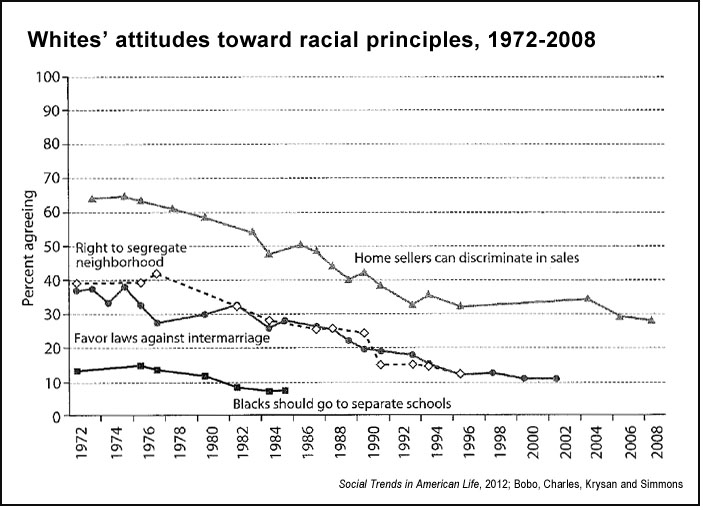The fatal shooting of teenager Michael Brown by a police officer in Ferguson, Mo., in August 2014, and the subsequent protests and police actions, has prompted an outpouring of analysis and opinion about the issue of race in America, as well as law enforcement behavior.
Many commentators have speculated about patterns of racism and racist views in American society. There are a wide range of sources for data that can inform coverage and deepen discussion. For example, in 2013 the Pew Research Center took stock of American racial attitudes on the 50th anniversary of the March on Washington. Pew found large gaps still between blacks and whites on how they see racial progress in America. From the criminal justice system to the workplace and schools, African-Americans were much more likely to say they are treated unfairly. Gallup also has a special section that spotlights historical trends in race relations since 2001.
The General Social Survey (GSS), run by the National Opinion Research Center at the University of Chicago, contains vital knowledge about attitudes in American society and can be usefully tapped by media to an even greater extent than it already is. The GSS has been conducted for more than four decades — since 1972 — and scholars carefully craft questions and measures that allow it to reveal deep insights into long-term shifts in Americans’ attitudes, unlike snapshot polls. On matters such as race relations, it is considered a gold standard and furnishes perhaps the most precise record available.
A 2012 book, Social Trends in American Life: Findings from the General Social Survey Since 1972, published by affiliated scholars and edited by Harvard’s Peter V. Marsden, synthesizes patterns of opinion on a wide variety of issues, including race. It contains a chapter-length paper, “The Real Record on Racial Attitudes,” by authors Lawrence D. Bobo of Harvard; Camille Z. Charles of the University of Pennsylvania; Maria Krysan of the University of Illinois, Chicago; and Alicia D. Simmons of Stanford. The data serve as cautionary notes to the belief that America has become “postracial” and underscore certain “enduring frictions and conflicts.”
Key findings of the article and the survey’s longitudinal data include:
- In 1972, “fewer than 15% of whites nationwide thought that black and white children should attend separate schools. That fell below 10% by the early 1980s. By 1985, so few people endorsed the segregationist response that the GSS dropped this item.”
- However, the data do not provide unequivocal support to the idea that the segregationist sentiment has entirely gone away. “In 2008, a nontrivial proportion of whites nationwide, 28%, still support an individual homeowner’s right to discriminate on the basis of race when selling a home, and even nearly 1 in 4 highly educated Northern whites adopt this position.”

- One part of more recent surveys (2000) showed respondents a “card depicting a 15-house neighborhood with their own home in the middle, and asked to indicate their preferred racial mixture by writing a ‘W’ (for white), ‘B’ (for black), ‘A’ (for Asian), or ‘H’ (for Hispanic) in the remaining homes.” The results “highlight the likely difficulty of creating stably integrated communities,” the researchers write. Indeed, “1 in 5 whites nationally created an ideal neighborhood that was all white; 1 in 4 created a neighborhood with no blacks in it; and 1 in 3 created a neighborhood with no Hispanics or no Asians.”
- Preferences among minority groups were different, but not without other bias: “Similarly, though fewer than 1 in 10 blacks created an all-black neighborhood or one with no whites, almost 2 out of 5 created ideal neighborhoods with no Hispanics or Asians in them.”
- In 1990 white respondents were asked if they were willing to live in a neighborhood where “half of your neighbors were blacks” and only 10% said they would. That figure rose to 25% in 2008.
- “When first measured in 1990, fully 65% of whites opposed a black-white union, while 40+% opposed Asian-white or Hispanic-white unions. The data since then reveal both a general decline in objection to racial intermarriage and a considerable narrowing of the size of the gap between opposition to black-white unions and either Asian- or Hispanic-white unions. Nonetheless, even in 2008, 1 in 4 whites either ‘opposed’ or ‘strongly opposed’ a close relative or family member marrying a black person.”
- “In 1990, when first assessed, roughly 65% of whites rated blacks as less hard-working than whites, while just under 60% rated blacks as less intelligent than whites. Such negative stereotyping subsequently falls for both traits, particularly between 1990 and 1996, remaining relatively stable over the ensuing decade.”

- Several notable trends are detectable among African-Americans surveyed, though the researchers state that the survey sample size should be increased to confirm these trends: “First, blacks are less and less likely to explain racial inequality in structural, discrimination-based terms. Second, blacks have shifted discernibly toward more motivational and cultural accounts of racial inequality. Third, black support for certain forms of government intervention to advance the status of African-Americans has declined.”
The scholars caution against simplistic pronouncements but note that the overall record of GSS data “strongly points to a large and growing orbit of social and political acceptance for African-Americans. This too is borne out by manifold behavioral evidence: the growth and size of the black middle class, declining levels of racial residential segregation, and even the election of Barack Obama as the 44th (and first African American) president of the United States.” However, “despite accepting integration as a general principle and a small minority presence in schools, neighborhoods or other public social spaces, whites express strong social distance preferences; indeed, a racial hierarchy of association remains, with African Americans at or near its bottom.”
Related: Also see the New York Times’ “Upshot” blog for a visualization of some trends relating to racial attitudes extracted from the GSS.
Keywords: African-American, law, discrimination, racism, Hispanic, Latino

Expert Commentary